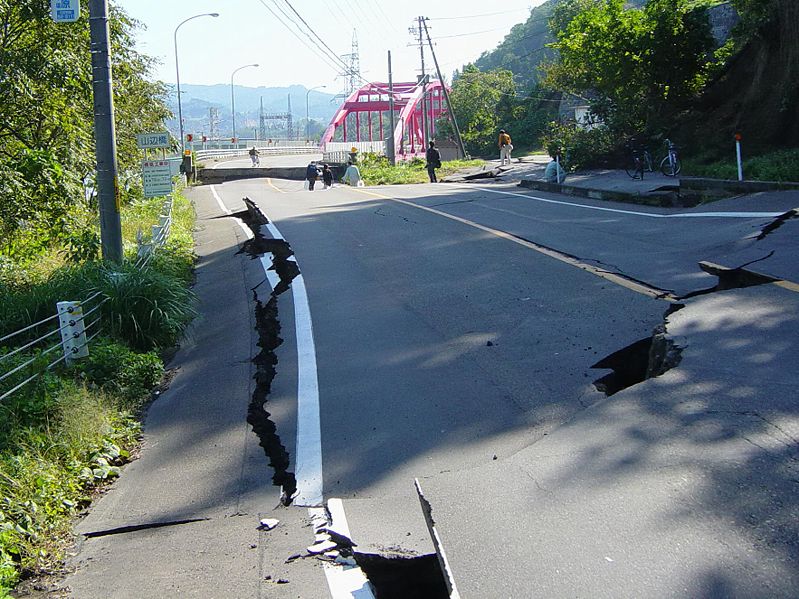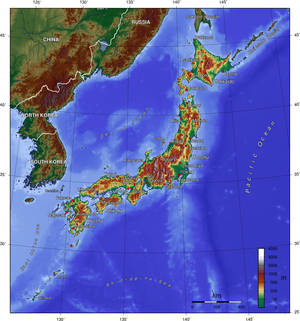This was a discussion held in the evening on Sunday, 13th March...
Sarah - First of all, just to recap on the situation. On the 11th of March, a massive major earthquake struck off the eastern coast of Japan. It was measured at an 8.9 magnitude and it was a mega thrust earthquake which is the type that you get where you have a subduction zone, where you have one tectonic plate being squeezed underneath another one. It hit about 130 kilometres east of Sendai which is in Honshu, which is the big main island, and the epicentre was in the Japan Trench, which is where you have the Pacific plates subducting under parts of the Eurasian plates. Although the earthquake was actually massive, what caused a lot of the damage was the 10-meter wave tsunami, so it's caused huge amounts of damage in the country.
Chris - A part of the reason why Japan suffers so many quakes is because they're not unusual there, are they? They're getting hundreds a year. It's because it's at the uniting point of three major plates.
 Sarah - Exactly. It's the meeting between the Philippine, the Pacific, and the Eurasian plates. So there's a lot of chances there for various different source of earthquakes. So the ones where you have plates sliding along each other or subducting underneath each other which is what happened in this case.
Sarah - Exactly. It's the meeting between the Philippine, the Pacific, and the Eurasian plates. So there's a lot of chances there for various different source of earthquakes. So the ones where you have plates sliding along each other or subducting underneath each other which is what happened in this case.
Chris - Dave, what's actually going on is you've got huge amounts of material moving or trying to move. It gets to a point where it can't move because you have a plate boundary and therefore, energy is getting stored up, and eventually gives and unleashes all that stored energy from many, many years of movement, but all at once.
Dave - Yeah, that's right. Essentially, it's a huge amount of elastic energy. It was an 8.9 Richter scale earthquake, that's equivalent to 300 million tons of TNT going off all at once. It's an immense amount of energy.
Chris - Is that unprecedented? Have we had one that big before?
Dave - It's certainly in our top 10 earthquakes since we've been measuring them in the last 150 years, so it's a really, really, really serious earthquake.
Chris - Could you talk us through the mechanism of how we ended up with the tsunami. What actually would have provoked that?
Dave - Fundamentally, because you've got one plate being pushed under the other one, so as the strain energy is building up, the plate is getting bent downwards, and effectively, it's pushing up the other plate and all of a sudden, it jumps and the Pacific plate jumps downwards and the Japanese plate jumps upwards. That lifts up billions and billions of tons of water by - I'm not sure what the throw was in the earthquake, but it's probably going to be a few meters. All of a sudden, you've got a huge amount of water, several meters higher that it should be. That creates a great big wave. It then moves in towards the coast. As any wave runs up the coast, it gets higher and higher, and higher. Out in the deep ocean, you don't really notice them, but as they run up the coast, it becomes higher and higher, and higher, and it will cause really big damage.
 Chris - Is that because you've got lots of waves catching up with each other or is it because the energy would be dissipated across a very deep ocean, but as it gets into shallow water, now you've got the same amount of energy, but in much less water, so you can move that water through a much greater distance to dissipate the same amount of energy?
Chris - Is that because you've got lots of waves catching up with each other or is it because the energy would be dissipated across a very deep ocean, but as it gets into shallow water, now you've got the same amount of energy, but in much less water, so you can move that water through a much greater distance to dissipate the same amount of energy?
Dave - Yes, essentially, it has a huge amount of momentum. When it's in deep water, it converts that into height and so, it gets higher and higher. Also, the really big thing is that it has a very, very long wavelength so you get a huge amount of water rather than a short wave, you've got water rushing up and then rushing down. It's like a tide coming in and out very quickly.
Chris - Which is why it's so devastating. Sarah, what about the nuclear threat? Where are we with that?
Sarah - It's Fukushima Nuclear Power Plant that are having problems at the moment, but I think the key point to make is that a lot of people are probably concerned because you see that today, there were pictures of people being tested for radiation and a small amount of people have tested positive, but I think a lot of people are concerned, could this be another Chernobyl? Could there be a really serious risk to the local population? I think in general, the answer seems to be no, just because of the type of reactor that it is. It's cooled by water. If something like this happens, you have all these control rods that get put down into the nuclear source which absorbs all the neutrons that they're releasing, and helps to stop the energy being produced, but you do still have delayed neutron precursors, and they still keep releasing neutrons for a certain amount of time after this which means you do still get heat building up, so they still need to cool the reactor after it's been shut down.
Chris - And the fact that they're having these problems is that because the cooling isn't working?
Sarah - I think they were having some problem with the water cooling, but I'm not sure what the situation with this.
Dave - I think essentially, they should have pumps pumping water around it which is keeping it cool. The system is designed so that even if the power goes off and the reactor stop producing power, it should have backup generators. I think the big problem they've had is their backup generators have failed which means it stopped pumping water around which means that it's been overheating, and causing all sorts of subsequent problems.
Chris - If the worst case scenario does occur and there is an explosion, how likely is it that there'll be widespread contamination?
Dave - There's already been an explosion high up, but that wasn't a nuclear explosion by any means. It even wouldn't get a nuclear explosion anyway. Hydrogen was being generated and that hydrogen has build up in the top of the building, and they haven't vented it properly, and therefore, the hydrogen just exploded. It's a very, very serious situation, but at the moment, the amount of radiation which is being released is not good, but it's still less than an x-ray, for the people who have been exposed certainly outside the plant itself.
Chris - And also, I think it's worth bearing in mind that Chernobyl was along while ago and the Japanese technology is way in advance of what we have today.
Dave - This is still a '70s reactor which was built in the early '70s.
Sarah - But the key point here is that the moderator isn't made of graphite which is essentially combustible, which is what the problem was in Chernobyl. It set fire because of heat whereas the moderator here is water. Obviously, it's not going to catch fire, so it's less of a problem. And also, these plants are designed - every possible thing that could go wrong, they think of that and think right, "How can we deal with that?" So they are designed to be as safe as possible.









Comments
Add a comment